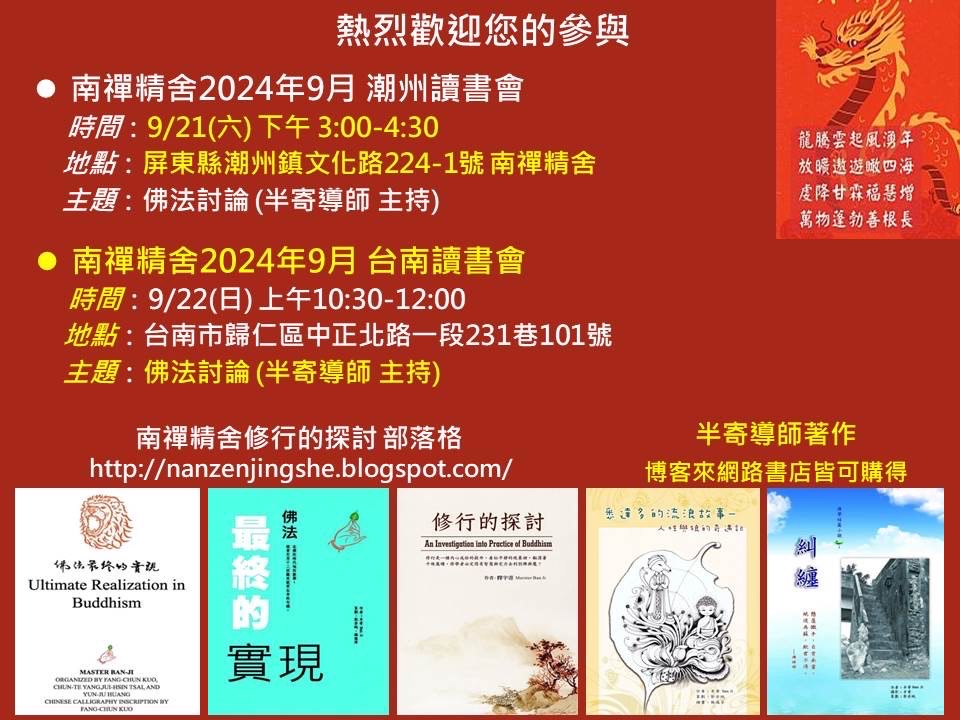Search For Enlightenment with Nan Zen Vihara; An Investigation into Practice of Buddhism
2024年8月31日 星期六
讀書會3補充解釋
2024年8月25日 星期日
讀書會3Book Club《中觀論》no coming, no going
讀書會3
Book Club 3
《中觀論》八不裡面不承認來去,就是《不來不去》。舉例; 我走到前面-目標設定是前面,設定就構成「來去」的認知,到達目的地,設定消失, 如不立前面(目標),就只剩下運動,運動裡面沒有來去-這是粗觀(較容易認知的內容)。
One of the pairs in the eight negations in the Treatise on the Middle Way is “no coming, no going.” For example, when I walk forward, I set “forward” as my destination, and this entails the perception of “coming and going,” and when I reach this destination, this intention to go forward comes to an end. However, if I go forward without setting “forward” as the destination, only the movement remains, without the concept of coming and going. This is seeing things on a general level, a simplified way of explaining it.
細觀-則還要加入時間有無存在的問題。 因為我們都習慣座標、認定,所以要突破「來去」簡直是找自己麻煩,還要外加「不」來「不」去,宛如「天關」直聳眼前!
Taking a more detailed approach, we have to take into consideration whether or not time exists. Since we habitually desire certainty, we tend to have a lot of difficulty seeing through and transcending the concept of coming and going, not to mention the idea of neither coming nor going!
如能克服自我的慣性(慣性如同重力拉著身體,身體根深的慣性運作不會幫助自己去脫離慣性,哈!) ,力克慣性才能進入「諸行無常」的認知。這也是運動產生的變化性,運動進入深觀,「來、去」消失。 如此,行雲流水的體現將豐富修行者的世界。
Only after endeavoring to overcome our mental inertia can we recognize that all conditioned things are impermanent. Our mental inertia is like gravity, pulling the body, and the bodypulled by the deep-rooted inertial will not push itself to escape from the inertia, haha! This is a transformation produced by movement, and when movement is seen on a deeper level, both coming and going cease. This is how someone far advanced in spiritual practice sees the world---as evanescent as floating clouds and flowing water.
(華人世界廣為流傳的《般若心經》 一開頭就明白講;「觀自在菩薩行深般若波羅蜜時(進入深觀)照見五蘊皆空」。)
In this connection, there is the famous opening line of the Heart Sūtra, “While Guanyin Bodhisattva was abiding in the profound perfection of wisdom, i.e. entering seeing things on a deeper level, he observed the emptiness of the five aggregates.”
半寄
Master Banji
Translated by Ken Kraynak
2024年8月24日 星期六
中觀論讀書會2. Book Club2
讀書會2
Book Club 2
遇到看不懂佛法的方法, 例如;「去我執」這詞,如用推敲方法如下, 我把「我執」去了!
那就變成「我」以外還有一個「我」, 所以才有一個「我」可以去, 哪留下的這個我是?
如果沒有另一個我可以「去」,那「去我執」得再想想🤔
這是我個人的推敲方法之一,提供參考。
When you come across a teaching in Buddhism that you find difficult to wrap your brain around, there are various ways you can approach it. For example, if you’re grappling with the idea of getting rid of self-attachment, it can help to ask yourself: It becomes that there is another ‘self’ besides ‘self’, so there is a‘self’ to eradicate. What is the sense of self that remains once self-attachment is eradicated? In other words, if there is no self to get rid of, then what does it mean to get rid of self-attachment? I’ve found it helpful to think of it in this way, and you might too.
「破我執」直接在本身作因緣法思索,大方向是觀察什麼原因讓自己抓著執著,自己「抓著執著」若意會到會讓自己莞爾一笑!
Eradicating self-attachment entails directly contemplating the causes and conditions related to its arising, so as to reveal how this attachment to self arises. It can be amusing to realize how this attachment comes about,recognizing that you are ‘graspingattachment’.
讀書會的雅玲老師對中觀27道題的回應是; 「師父:我最近看了中觀-中論27道題這本書,第一章因緣,就讓我看得頭昏腦脹的。但,頭腦真的有在被洗的感覺,它不斷的在挑戰頭腦。我昨天很恐懼時,我在想,我的恐懼為什麼?」
During the book club Yaling commented, “Shifu, while recently reading the first chapter on causality in Nāgārjuna’s Middle Way, my head was spinning. Still, grappling with this highly challenging material has also had a kind of cleansing affect on my mind. For example, yesterday I was feeling very apprehensive about something, but I somehow had the presence of mind to ask myself, ‘Where is this fear coming from?’”
人是肉體,時刻被各種情緒包圍,我個人已養成從種種角度看到自己的感受,或許是ㄧ份佛法的理性ㄧ直伴隨,很多事情的解脫已不關乎執著。
Being human means having a body, as well as experiencing emotions that assail us at any moment. I’ve made it a habit to examine whatever I experience from multiple perspectives, and I’ve found that when examining something from the perspective of Buddhist principles, the liberation of many things no longer has anything to do with attachment.
半寄
Master Ban Ji
Translated by Ken Kraynak
2024年8月23日 星期五
中觀論讀書會1 Book Club1
南禪朋友好!
6月讀書會的時候,幾位學理工的居士唉聲嘆說: 《解讀龍樹菩薩〈中論〉27道題》這本書讓大家看得焦頭爛額! 我則哈哈大笑!
Greetings, Friends of NanZen.
During the Book Club in June, several members majoring in sicence and engineering said that they were finding the Chinese translation of Nāgārjuna’s Middle Way, an annotated translation of the Mūlamadhyamakakārikā (Treatise on the Middle Way), to be exasperatingly abstruse, much to my amusement!
在我年輕的時候台灣講解《中觀論》的只有印順導師的糸列書籍可以做參考,我在看完印老糸列書藉後,又把西洋哲學史這些書籍全部看完,書中各式理論、及佛教論師們的推敲,有翻山越嶺的喜悅,也有搜索枯腸的焦慮!
When I first read the Treatise on the Middle Way many years ago, the only expository material on this topic was a series of books written by Master Yinshun. After reading them, I set about reading every book I could find on the history of Western philosophy, and I found the approach and manner of expression in all these works to be both delightful and exasperating.
40年過去龍樹菩薩的「八不論空」是我個人植入腦海的修鍊。 從擔心《中觀論》的解說相關書籍太少,(我個人很清楚要做《中論》解說是多麽困難的任務,)如今,相關書籍也百家爭鳴。 如果說;修行者的修持生涯至關緊要的是「破我執」,那麼永遠祈盼《中觀論》「八不論空」正確的傳遞下去是我所願。
In the four decades since then, however, Nāgārjuna’s eight negations have become an integral part of my practice and how I think. I used to bemoan the lack of expository material on the middle way---I am well aware how challenging a task it is toexpound it---but today there are countless related publications. If eradication of self-attachment is of utmost importance in spiritual practice, may Nāgārjuna’s eight negations be correctly passed on!
半寄
Master Ban Ji
Translated by Ken Kraynak
2024年8月17日 星期六
觀察 Observe
南禪朋友早安!
南禪朋友早安!
在哲學、宗教、修行裡面,全世界只有佛法教導了『觀察』,
佛法要求修行者要善用『觀察』,
一個善用『觀察』的人『觀察』自己的內心(想法)『觀察』周遭的事物,達到自我進步的目的,
『觀察』一定會促使人產生不一樣的視野!
半寄
Good morning, friends of Nanzen.
In the world of philosophy, religion, and spiritual practice, only Buddhism strongly advocates ‘observation’.
Buddhism asks practitioners to ‘observe’ well.
A person who is good at ‘observation‘ ‘observes’ his own mind, i.e. thoughts, and things surrounding him to achieve the goal of self-improvement.
‘Observation’ will definitely give people a different perspective.
Translated by Grace Jui-hsin Tsai




